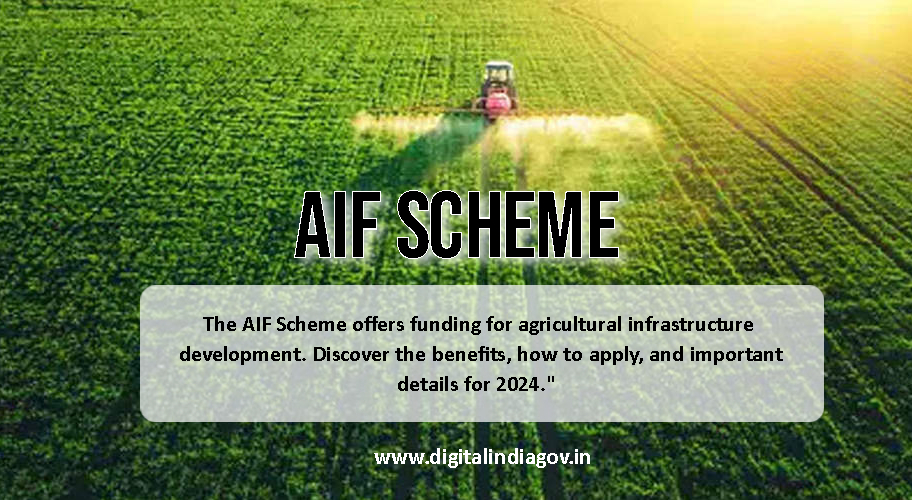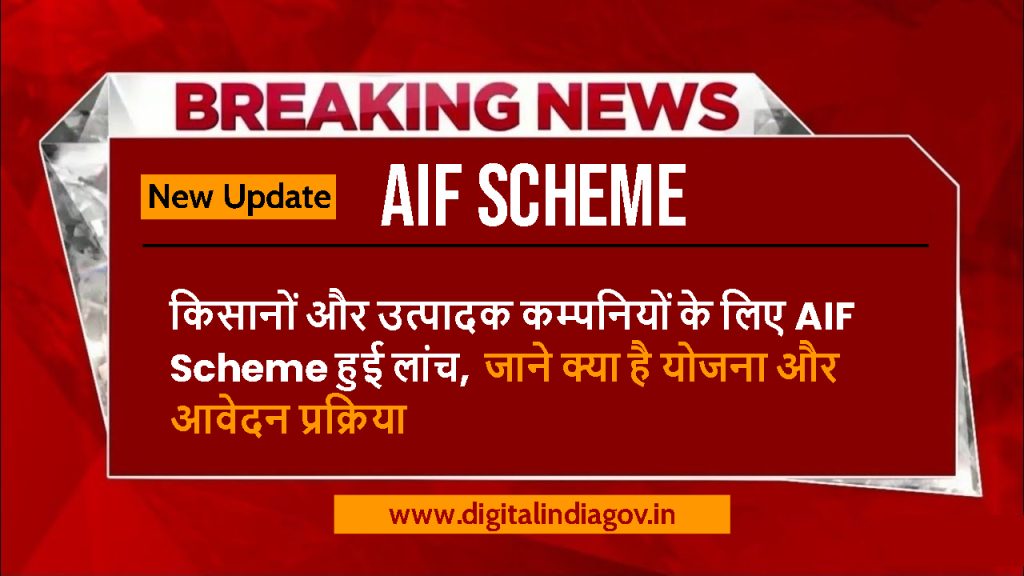AIF Scheme, Under the National Agriculture Infra Financing Facility (AIF Scheme), the Indian government is offering loans up to two crores. Under this plan, loans totalling Rs. 4928 crores have been given thus far. You can receive a 3% interest subsidy from the government if you also take out this government loan.
Contents
What is an AIF scheme?
AIF was started by the Prime Minister of India Shri Narendra Modi on 9th August 2020, this plan is totally supported by the Central Government which comes under the Ministry of Agriculture and Farmers Welfare, the tenure of this scheme will be from 2020 to 2019 which is 10 years. Important Points: This initiative is a component of the relief fund program that the Prime Minister initiated during COVID-19, with a budget of 20 lakh crores.
Also Read: PLI Scheme India, shaladarpanportalgov.com, yojanaforall.com, Onlinereferjobs
AIF Scheme Overview
| Name of the Scheme | Agriculture Infrastructure Fund |
| Scheme Budget | 1 lakh crore |
| Beneficiaries | Farmer Producer Organizations, State Agencies, Farmers and Agri-entrepreneurs etc. |
| Farmer Minimum Contribution | 10 % |
| Application Process | By bank |
| Objective | Promoting agricultural storage |
| Financial Help | 1 lakh to 2 crore |
| Loan Repayment Time | Maximum 5-7 years |
| Moratorium Time | 6 months to 2 years |
| Maximum Project | 25 projects |
| Benefits | 3% discount on loan interest and no bank can give loan at more than 9% CGTMSE fees waived |
| Official Website | Department of Agriculture and Farmers Welfare |
Why has the AIF Scheme been started?

As is well known, India’s economy is based primarily on agriculture. The central government was working nonstop to make it better and more efficient. 42% of India’s population makes their living from agriculture, however because of poor infrastructure, farmers there frequently deal with a number of issues following crop harvest. The Government of India has introduced this initiative to remove these issues.
- Similar to rain falling after harvesting and spoiling the crop.
- Many crops spoil from too much sunshine because there is nowhere to keep them once they are harvested.
- For a variety of reasons, including selling the produce for a low price even when harvesting did not yield a good price, Indian farmers suffer significant losses.
Objective of the AIF Scheme
This scheme’s primary goal is to lend money to farmers so they may create infrastructure or to persons who want to start a new agricultural-related business, including creating warehouses for crops or ripening fruit, among other things.
- To expand India’s agricultural storage capacity.
- To enhance post-harvest procedures in order to lower losses and boost farmer income.
- To aid Farmer Producer Organisations (FPOs) and agri-entrepreneurs in their development initiatives.
Benefits of AIF Scheme
- Boost in Income for Farmers: Through financial assistance and investments made in agriculture, the AIF will raise farm productivity and increase farmers’ income.
- Reduction of Post-Harvest Losses: If AIFs are used properly, they can enhance storage, logistics, and infrastructure, which can enhance farmers’ returns by lowering post-harvest losses.
- Reducing reliance on middlemen and expanding market access are two benefits of improved market infrastructure for farmers who sell directly to a wider consumer base.
- Promote Community agriculture: AIFs that assist community agricultural assets result in better input use and significant cost savings for farmers, which raises output levels all around.
- Risk Mitigation: Lending institutions can grow their clientele and diversify their portfolios in farm finance by lowering risk through credit guarantees, incentives, and interest subvention.
- Benefits for Consumers: As a result of more food reaching markets and better quality and competitive prices, consumers gain from streamlined post-harvest processing.
Limitations of the AIF Scheme
- FPO Viability Concerns: Examining the scheme’s possible advantages for Farmer Producer Organisations (FPOs) and raising concerns about its sustainability.
- Data Transparency on Institutional Funding: This section draws attention to the lack of trustworthy data on the flow of funds to FPOs from organisations like SFAC, NABARD, and State agencies, raising questions about transparency.
- The Agriculture Investment Fund (AIF) is a market intervention strategy for market infrastructure institutions. However, its exact role in market intervention is unclear.
- Lack of Convergence with Current Schemes: This study looks at the lack of a mechanism for convergence with current schemes, such as the PEG scheme, which has drawn corporate and private investment to the agricultural sector.
- Challenges of eNAM Integration for APMCs: This paper examines the possible restrictions on the growth of Agricultural Produce Market Committees (APMCs) through their integration into the electronic National Agricultural Market (eNAM) framework in the absence of a monitoring and evaluation cell.

Also Read: SANKALP Scheme, Mobilenumbertrackeronline, indnewsupdates.com, ssorajasthanidlogin.com
How To Apply For Agri Infrastructure Fund?
All of our readers and farmers who would like to use this software can accomplish that by following these steps:
Step 1: create a new account on the internet site
- A way to apply for agri infrastructure fund i.e. AIF scheme practice online 2024 purpose to accomplish this, you have to first visit your legitimate website’s domestic web page, which looks as if this:
- When you attain the house web page, the beneficiary corner region can be located.
- This segment will include a beneficiary registration option which you should click on.
- Following your click, the subsequent new page will appear in front of you:
- You now need to provide your name, phone number, and Aadhar card number on this page.
- Following that, you must click the Send OTP option to complete OTP Verification.
- The completed Registration Form will now be in front of you; it must be thoroughly filled out and
- Lastly, you must select the Submit button to receive your login credentials, which you must store securely.
Step 2 – Apply online by logging into the portal
- You will need to log in to the portal after completing the registration process.
- The portal’s application form will be in front of you after you log in.
- You must now carefully fill out this application.
- The necessary paperwork must all be scanned, uploaded, and
- Ultimately, you must select the “Submit” option to receive your application slip, which you must then print, among other things.
- You can easily invest in this scheme and reap its rewards by following the preceding procedures.
What is the AIF Scheme Subsidy?
| PMFME Scheme | Capital Subsidy |
| CGTMSE Scheme | No Collateral |
| AIF Scheme | 3% interest subsidy |
Some benefits of an AIF loan are as follows: if you combine the PMFME or CGTMSE schemes with the AIF scheme, you will be eligible for interest subsidy in addition to the loan amount; if you combine these schemes with the AIF scheme, you won’t have to mortgage anything to the bank.
| PMFME Scheme + AIF Scheme | Discounts on loans and interest |
| PMFME Scheme+ CGTMSE Scheme + AIF Scheme | Loan + Interest + Discount on Mortgage of Property |
AIF Scheme Loan Documents
Depending on the kind of loan you are taking out, the list of all the loan documents is provided below. The paperwork you need to provide depends on the kind of loan you’re taking out.
- Loan Application Form
- Passport with Photograph
- Identity Card (Aadhar Card, PAN Card, Voter ID)
- Address Proof
- Registration Certificate
- Income Tax Returns for the last three years
- Value Sheet of last three years
- GST Certificate
- Land Documents
- Bank Statement of last year
- Record of previous loans taken
- Statement of the current loan
- Income Certificate
- Detailed Project Information
- Local Authority Permission Letter
Way Forward to the AIF Scheme

- AIF Fund Modification for Market Integration: To improve market integration and guarantee dependable price discovery, AIF funds connected to agricultural commodities derivative markets must be modified.
- Converging the Agriculture Infrastructure Fund (AIF) with other programs: The AIF can be integrated with multiple programs. Combining state-specific agricultural financing schemes with the AIF, for instance, will yield more fruitful results.
- Raising Awareness: If farmers and Self-Help Groups (SHGs) are aware of the facilities offered by the AIF, then the AIF may be fully utilised. Arrange state conclaves to raise interest in and understanding of the plan among interested parties.
- Strengthening Governance: AIF will be able to reach its target sectors even more if it can ensure that the money movement is transparent and sets up an oversight committee. It has been recommended that banks designate an AIF nodal officer at the main office. Regarding every facet of the AIF plan, this nodal officer will serve as a conduit for coordination and communication with other parties.
Also Read: PM Scholarship Scheme, digitizeindiagovin.com, Typingspeedtestonline, Nebsit Council
Conclusion
We hope that you enjoyed reading this article so much that you will like, share, and comment on it. We have provided all of you readers and citizens with detailed information about the AIF Scheme 2024 as well as the online registration process, enabling you to invest in the scheme and benefit from it with ease.
Faq’s
Q. For whom is AIF appropriate?
Ans: Partnerships and proprietary businesses, as well as Registered Farmer Producer Organisations. Organisations: corporations, NGOs, Self Help Groups (SHGs), Cooperatives, Cooperative Marketing Federations, Local Bodies (except Municipal Corporations for projects involving storage infrastructure), Autonomous Bodies of the Government, Panchayats.
Q. What is the AIF loan cap?
Ans: Rs. 2 Crore Repayment: A six-to 24-month moratorium will be included in the ten (10) year repayment period. Until the loan cap of Rs. 2 Cr. is reached: 6M MCLR + 100 bps.
@PAY
